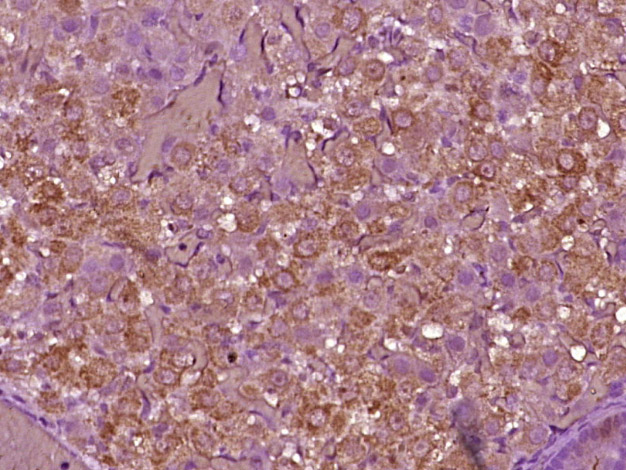
Rabbit Anti-LHR antibody
Gonadotropin receptor; CGR; hCG receptor; FLJ41504; Gpcr19-rs1; GTHR-II; HHG; LCGR; LGR2; LH-R; LH/CG R; LH/CG-R; LH RECEPTOR; LH/CGR; LHCGR; LHRHR; LSH R; LSH-R; LSHR_HUMAN; Luteinizing hormone receptor; Luteinizing hormone/choriogonadotropin receptor; l
View History [Clear]
Details
Product Name LHR Chinese Name 促黄体生成素受体抗体 Alias Gonadotropin receptor; CGR; hCG receptor; FLJ41504; Gpcr19-rs1; GTHR-II; HHG; LCGR; LGR2; LH-R; LH/CG R; LH/CG-R; LH RECEPTOR; LH/CGR; LHCGR; LHRHR; LSH R; LSH-R; LSHR_HUMAN; Luteinizing hormone receptor; Luteinizing hormone/choriogonadotropin receptor; luteinizing hormone/choriogonadotropin receptor; Lutropin choriogonadotropic hormone receptor; Lutropin choriogonadotropic receptor; Lutropin-choriogonadotropic hormone receptor; ULG5. literatures Research Area Cell biology Neurobiology Growth factors and hormones Endocrinopathy Immunogen Species Rabbit Clonality Polyclonal React Species Human, Rat, (predicted: Mouse, Pig, Cow, Horse, Rabbit, Sheep, ) Applications ELISA=1:5000-10000 IHC-P=1:100-500 IHC-F=1:100-500 IF=1:100-500 (Paraffin sections need antigen repair)
not yet tested in other applications.
optimal dilutions/concentrations should be determined by the end user.Theoretical molecular weight 74kDa Cellular localization The cell membrane Form Liquid Concentration 1mg/ml immunogen KLH conjugated synthetic peptide derived from human LHR/CGR: 201-300/699 <Extracellular> Lsotype IgG Purification affinity purified by Protein A Buffer Solution 0.01M TBS(pH7.4) with 1% BSA, 0.03% Proclin300 and 50% Glycerol. Storage Shipped at 4℃. Store at -20 °C for one year. Avoid repeated freeze/thaw cycles. Attention This product as supplied is intended for research use only, not for use in human, therapeutic or diagnostic applications. PubMed PubMed Product Detail This gene encodes the receptor for both luteinizing hormone and choriogonadotropin. This receptor belongs to the G-protein coupled receptor 1 family, and its activity is mediated by G proteins which activate adenylate cyclase. Mutations in this gene result in disorders of male secondary sexual character development, including familial male precocious puberty, also known as testotoxicosis, hypogonadotropic hypogonadism, Leydig cell adenoma with precocious puberty, and male pseudohermaphtoditism with Leydig cell hypoplasia. [provided by RefSeq]
Function:
Receptor for lutropin-choriogonadotropic hormone. The activity of this receptor is mediated by G proteins which activate adenylate cyclase.
Subcellular Location:
Cell membrane; Multi-pass membrane protein.
Tissue Specificity:
Gonadal and thyroid cells.
DISEASE:
Familial male precocious puberty (FMPP) [MIM:176410]: In FMPP the receptor is constitutively activated. Note=The disease is caused by mutations affecting the gene represented in this entry.
Luteinizing hormone resistance (LHR) [MIM:238320]: An autosomal recessive disorder characterized by unresponsiveness to luteinizing hormone, defective sexual development in males, and defective follicular development and ovulation, amenorrhea and infertility in females. Two forms of the disorder have been defined in males. Type 1 is a severe form characterized by complete 46,XY male pseudohermaphroditism, low testosterone and high luteinizing hormone levels, total lack of responsiveness to luteinizing and chorionic gonadotropin hormones, lack of breast development, and absent development of secondary male sex characteristics. Type 2, a milder form, displays a broader range of phenotypic expression ranging from micropenis to severe hypospadias. Note=The disease is caused by mutations affecting the gene represented in this entry.
Similarity:
Belongs to the G-protein coupled receptor 1 family. FSH/LSH/TSH subfamily.
Contains 6 LRR (leucine-rich) repeats.
Contains 1 LRRNT domain.
SWISS:
P22888
Gene ID:
3973
Database links:Entrez Gene: 3973 Human
Omim: 152790 Human
SwissProt: P22888 Human
Unigene: 468490 Human
Unigene: 11216 Rat
Product Picture
References (0)
No References
Bought notes(bought amounts latest0)
No one bought this product
User Comment(Total0User Comment Num)
- No comment



 +86 571 56623320
+86 571 56623320
 +86 18668110335
+86 18668110335

